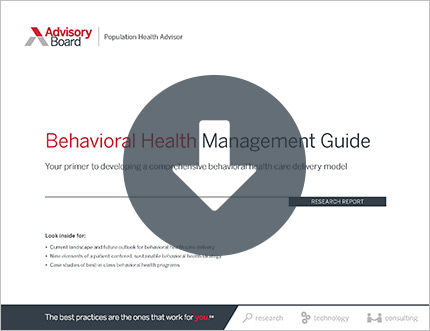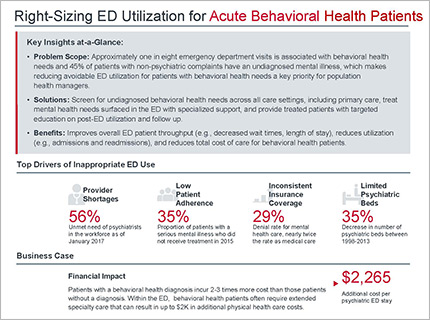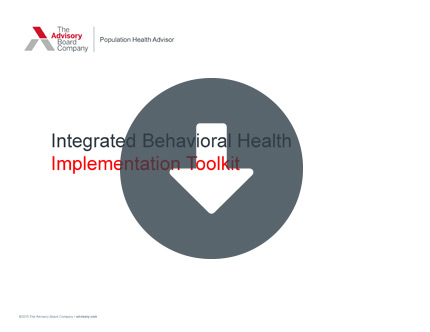Auto logout in seconds.
Continue LogoutFew studies to date have examined how depressed patients fare in the years after their diagnosis—but now, new research is shining light on life after depression, the Benedict Carey reports for the New York Times.
Follow these 6 steps to integrate behavioral health with other care
What researchers don't know about life after depression
Johnathan Rottenberg, a psychology professor at the University of South Florida, said it is not uncommon for patients diagnosed with depression to ask, "[W]hat are the chances of my life returning to normal?"
But Rottenberg said researchers cannot currently answer that question.
In a paper published in Perspective on Psychological Science, Rottenberg—along with Todd Kashdan and David Disabato of George Mason University, and Andrew Devendorf of the University of South Florida—argue that researchers in hundreds of past studies on depression have ignored the potentially large group of patients who once had depression but then recovered.
Carey reports that the oversight is so severe that there is essentially no information on the demographics of the recovered group or research into their current conditions.
"I think it's embarrassing that we don't [have an answer]," Rottenberg said.
As a result, Sheri Johnson, director of the mania program at the University of California-Berkley, said researchers cannot predict which patients with depression are more likely to flourish after treatment.
Closing the research gap
In an effort to bridge the research gap, Rottenberg and his colleagues analyzed long-term data on more than 500 individuals between the ages of 25 and 75 who had been diagnosed with depression and participated in the Midlife Development in the United States national survey.
In a study, which will be published in Clinical Psychological Science, the researchers determined that half of the people who had depression eventually recovered, which the authors defined as being without symptoms of depression for at least 12 months.
The researchers deemed a smaller group—about 10% of participants who had depression—"flourishers," meaning that they were thriving 10 years later.
Rottenberg noted that further research is needed, ideally from a study that would follow a larger group of people who recovered from depression to find out what separates the people who thrive from those who do not.
What does this mean for people who have depression?
Nada Stotland, a psychiatrist at Rush University Medical Center in Chicago, said it is "a good idea ... to look at people who do well after a period of depression, over the longer term," but suggested the results might show that the people who are "thriving" are "the people who were doing better in the first place."
Carey reports that treating depression can be difficult because the effects of treatment vary from person to person. Some people "might swear by daily pills, others may depend on weekly talk therapy. Good friends, good opportunities, and good genes are likely to play a role," Carey reports. There also are some patients who overcame their condition with treatment methods they devised on their own, Carey reports.
Regardless, Rottenberg said, "[I]t would be exciting to find out what those [treatment methods] are." He added, "You'd not only be giving people with depression some hope, by studying this group. You might also be able to give them something they could use" (Carey, New York Times, 10/22).
Six steps to integrate behavioral health with other care
Behavioral health issues can exacerbate other health conditions and make patients less likely to comply with important care plan aspects. Since most patients are diagnosed in the primary care setting, integrated behavioral health models can ensure patients follow through with referrals to mental health care.
Download our toolkit to find resources to effectively address six critical components of an integrated behavioral health program.
Don't miss out on the latest Advisory Board insights
Create your free account to access 1 resource, including the latest research and webinars.
Want access without creating an account?
You have 1 free members-only resource remaining this month.
1 free members-only resources remaining
1 free members-only resources remaining
You've reached your limit of free insights
Become a member to access all of Advisory Board's resources, events, and experts
Never miss out on the latest innovative health care content tailored to you.
Benefits include:
You've reached your limit of free insights
Become a member to access all of Advisory Board's resources, events, and experts
Never miss out on the latest innovative health care content tailored to you.
Benefits include:
This content is available through your Curated Research partnership with Advisory Board. Click on ‘view this resource’ to read the full piece
Email ask@advisory.com to learn more
Click on ‘Become a Member’ to learn about the benefits of a Full-Access partnership with Advisory Board
Never miss out on the latest innovative health care content tailored to you.
Benefits Include:
This is for members only. Learn more.
Click on ‘Become a Member’ to learn about the benefits of a Full-Access partnership with Advisory Board
Never miss out on the latest innovative health care content tailored to you.



